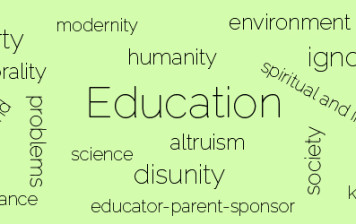
Caroline Teea and David Shankland
The commitment and hard work of teachers in Hizmet schools is a significant factor behind their academic success. Teachers are willing to work harder and for longer hours than their counterparts in other schools, and are not paid any more to do so. This willingness is referred to internally in the movement as fedakarlık (self-sacrifice), and is highly prized and encouraged. Sociologically, the Weberian notion of “inner worldly asceticism” provides a framework for understanding how pious religious convictions might motivate Hizmet (Gülen Movement) followers to exert themselves in pursuit of apparently “worldly” activities for little personal gain (Agai 2002, Özdalga 2000, Yavuz 2013).
In girls’ school at School A (a school in Turkey), the majority of teachers was religiously observant and projected a pious Islamic identity. This piety was expressed in various ways, namely their choice of a strict tesettür style of clothing, (1) their regular visits to the designated prayer room to perform namaz throughout the course of the school day, and the preference for teaching in an all-female environment because it was “more comfortable” (daha rahat) without the presence of men. The piety of the staff was generally more uniform than that of the students. That is to say, not all of the girls adopted the tesettür dress code outside of school, and not all performed regular prayers. The extent to which the religious piety of the teachers influenced their students’ own religious observance, and shaped them into future transmitters of the Nursian-Gülenist worldview, was an important question that we decided deserved a separate study. Notwithstanding, the teachers at the schools framed their commitment to teaching in religious terms, with reference to the books and sermons of Fethullah Gülen. As a central principle in Gülen’s teachings, the concept of temsil (witnessing to one’s faith through action rather than words) was one to which many of the teachers in this study made reference when talking about their responsibilities as teachers. (2)
Gülen regards teaching as a kind of sacred duty, an act of religious piety in the service of God (Agai 2002, Ünal and Williams 2000). While the pursuit of religious knowledge has long had a sacred function in the Islamic tradition (Hefner and Zaman, 2007), Gülen re-interprets this tradition to “sanctify” and legitimize the teaching and learning of non-sacred subjects in a secular environment. In this way, he encourages his followers to teach as a kind of religious service (hizmet) or vocation, stating that:
Education through learning and a commendable way of life is a sublime duty that manifests the Divine name Rabb (Upbringer and Sustainer). By fulfilling it, we attain the rank of true humanity and become a beneficial element of society. […] In essence, a school is a kind of place of worship whose ‘holy people’ are teachers. (Gülen quoted in Ünal and Williams 2000: 308 and 312)
Teachers are therefore highly motivated to carry out their duties as diligently as possible, seeing their professional role as having sacred connotations. Furthermore, teachers locate additional spiritual meaning in their professional vocation, which is the provision of guidance (irşad) to their students. Gülen praises the giving of guidance, which can be understood as showing a believer the ‘right path’, declaring, “if there is one thing that is most enduring in this world and the most meritorious in the Hereafter, it is guidance” (Gülen 2004, Chapter 23). A familiar concept in the Sufi tradition, Gülen’s understanding of guidance is unusual in that he does not see it as the preserve of a sheikh (mürşid) or religious leader, but something to which “ordinary” Muslims can aspire; furthermore, reflecting the broad principles of the Nursian intellectual tradition, Gülen’s view of guidance is that it ought to incorporate wisdom on scientific as well as religious topics:
A guide is a wise one equipped with the necessary knowledge of both religious and certain secular sciences to discuss different subjects with an audience and present satisfactory solutions to their problems (Gülen 2004, Chapter 23, “Irshad and Murshid”).
Hizmet schools have been extremely careful to adhere to secular legal requirements in Turkey, in order to avoid closure. (3) Consequently, teachers wishing to be mürşids in the manner described above looked beyond the limitations of the timetabled school day, and interacted with students in their free time and in “neutral” spaces. Optional, teacher-led reading groups focusing on the Risale of Said Nursi, as well as the books of Gülen, were held after school at the students’ dormitory about a half-hour drive away from the school campus. The teachers also interacted socially with their students and saw a great deal of one another in a variety of informal social situations. For example, many teachers at the girls’ school in School A explained that they regularly invited their class students to their homes for meals at weekends, as exemplified by this conversation with a group of 9th grade (15 year old) students:
CT: Are you happy with this school?
Girls: Yes, very happy.
CT: What do you like about it most?
Girls: Our teachers. They are very concerned with us (çok ilgileniyorlar) and give us a lot of help with our lessons. They’re so much better than at state schools. In state schools, they just watch for the clock to strike four so that they can leave…
CT: Do you see your teacher outside of the school?
Girls: Yes, often! We visit [our class teacher] at her home. She often invites us over for breakfast at the weekend. In Ramadan, we even went once for sahur… (4)
It was common also for teachers to visit individual students in their own homes, and to cultivate a social relationship with parents as well. In this way, normal professional boundaries were blurred and a network of informal, family-wide relationships was forged, based for the most part on a common interpretation of the pious Islamic lifestyle. (5)
The way in which students interacted with the teaching staff was often more familial than it was professional, with teachers having an attitude in some ways more reminiscent of a “big sister” (abla) than a distant authority figure. Besides reciprocal home visits, this intimacy was cultivated when teachers would accompany students on social excursions such as trips to the cinema or to local shopping malls. At an organized school picnic, teachers and students mingled freely together socially. Teachers sat with their students, chatted and joked along with them, ate their meals with them, and even joined in playing certain games, such as skipping. Furthermore, however informally, it was clear that religious instruction was taking place; groups of students and teachers engaged intermittently in reading the Qur’an together, and others performed namaz throughout the course of the afternoon on mats laid out in the shade of some trees.
This informal, extra-curricular, personal and religious mentoring that teachers offered to students was exemplary of how the teachings of Said Nursi and Fethullah Gülen were transmitted and how a “Nursian spiritual worldview” was cultivated. An important component of this worldview was the proposed reconciliation of science and religious beliefs. Thus, while the secular science was taught in Hizmet classrooms, a broader philosophical framework in which science was framed in Islamic terms was nurtured outside the classroom, in private time, in neutral space, and in the context of close personal relationships.
Source:
Excerpted from the article “Said Nursi’s Notion of ‘Sacred Science’: Its Function and Application in Hizmet High School Education” in Sociology of Islam, 2013, pages 209–232.
Caroline Teea, Postdoctoral Research Assistant, Department of Archaeology and Anthropology, University of Bristol, UK
David Shankland, Department of Archaeology and Anthropology, University of Bristol; Director, Royal Anthropological Institute, London, UK
Notes:
(1) Tesettür is a conservative style of women’s Islamic dress in Turkey. Headscarves are mostly removed inside the school building.
(2) For a discussion of the Hizmet schools’ missionary function in Central Asia, see Balcı (2003); on the internal dynamics of the schools and the notion of teachers as “models” see Agai (2002).
(3) Provision for religious instruction in the Turkish national secondary curriculum is lim- ited to one hour per week. Teachers reported that the schools were visited unannounced on a fairly regular basis by inspectors from the Ministry of Education, who searched for reli- gious materials and who checked that additional religious activities were not being carried out on the school premises.
(4) Conversation between Caroline Tee and girls in a 9th grade chemistry class, girls’ school in School A, May 22, 2013. Sahur is the early-morning meal eaten shortly before sunrise in Ramadan. It is common to share iftar (the meal eaten at sunset) with friends and neighbors in Turkey, but visiting someone’s house to share sahur is unusual. The girls found this quite amusing and reported it enthusiastically.
(5) Such informal networks play a crucial role in the functioning of the Hizmet movement as a whole. See Hendrick (2013, 2009).
Abstract
This paper explores the teaching of natural science subjects in high schools associated with the Gülen-Hizmet movement in Turkey. It focuses on the apparent reconciliation of scientific learning in a pervasive, albeit unofficial, Sunni Islamic religious culture. The framework for such an accommodation is found in the teachings of Fethullah Gülen and his predecessor, Said Nursi. Following Nursi, Gülen encourages scientific pursuit, and intellectual knowledge in general, as a pious and spiritually meritorious act. Drawing on fieldwork conducted at two Hizmet-affiliated high schools in Turkey, this article explores the “sanctification” of science and learning in the Gülen Movement by highlighting the principle of fedakarlık (self-sacrifice), as the primary motivation of the teaching staff. Focusing also on the schools’ highly disciplined and competitive learning environments (as exemplified in preparations for the prestigious International Science Olympiads), the article suggests that although teacher commitment and prestigious competitive awards bolster the Hizmet schools’ market competitiveness, they fail in actually producing students who pursue careers in natural science fields. By contrast, this article concludes that the movement’s engagement with science, at least at present, is less interested in furthering scientific inquiry than it is in equipping what Gülen has called a ‘Golden Generation’ with the tools it needs to compete with secularist rivals in Turkey.
Tags: Education |Related Articles

Hizmet Schools: A new pedagogy
The challenge today, as Gülen sees it, is to find a way in which these traditional pedagogical systems can overcome the tendency to regard each other as rivals…

Pillars of Gulen’s educational philosophy: Problems education can solve
Yuksel A. Aslandogan, Muhammed Cetin The land where the world-renowned poet and Sufi Master Rumi lived and taught is now witnessing an unprecedented development with global effects. Teachers,…

Peaceful Muslim–Non-Muslim Co-existence in a Secular Context
Farhod Alimuhamedov This paper is about the conditions of inter-ethnic, inter-religious and inter-class relations in Gülen schools and looks into their operation in non-Turkish and non-Muslim settings. It…
